生物钟基因研究进展
生物钟的作用原理与研究进展
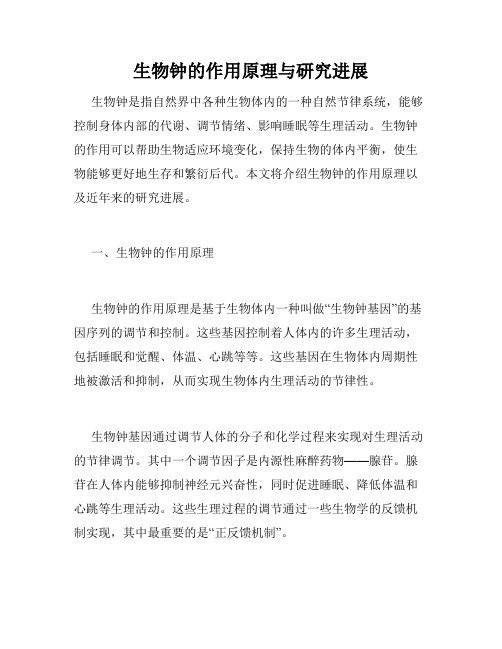
生物钟的作用原理与研究进展生物钟是指自然界中各种生物体内的一种自然节律系统,能够控制身体内部的代谢、调节情绪、影响睡眠等生理活动。
生物钟的作用可以帮助生物适应环境变化,保持生物的体内平衡,使生物能够更好地生存和繁衍后代。
本文将介绍生物钟的作用原理以及近年来的研究进展。
一、生物钟的作用原理生物钟的作用原理是基于生物体内一种叫做“生物钟基因”的基因序列的调节和控制。
这些基因控制着人体内的许多生理活动,包括睡眠和觉醒、体温、心跳等等。
这些基因在生物体内周期性地被激活和抑制,从而实现生物体内生理活动的节律性。
生物钟基因通过调节人体的分子和化学过程来实现对生理活动的节律调节。
其中一个调节因子是内源性麻醉药物——腺苷。
腺苷在人体内能够抑制神经元兴奋性,同时促进睡眠、降低体温和心跳等生理活动。
这些生理过程的调节通过一些生物学的反馈机制实现,其中最重要的是“正反馈机制”。
正反馈机制是指生物钟基因周期性激活激活自身的过程。
当生物钟基因被激活时,它们会产生蛋白质,这些蛋白质又能够激活生物钟基因的表达。
这种自我激活的过程形成了一个正反馈回路,让生物钟基因周期性地表达,从而驱动生物体内的生理节律。
二、生物钟的研究进展近年来,科学家对于生物钟的研究取得了许多重要的进展。
其中最重要的就是生物钟基因的发现。
科学家通过从飞蝗、小鼠、果蝇、人和真菌等生物体中筛选基因,发现了生物钟基因,进一步找到了控制生物节律的关键因子。
生物钟基因的发现为科学家提供了更多的研究手段,让他们能够更好地了解生物钟的调节和控制。
科学家通过改变生物钟基因的表达水平来研究生物钟,发现了生物钟与许多生理过程的关系。
除了生物钟基因的发现,科学家还通过一些生理学和神经科学的研究,发现了环境因素对生物钟的影响。
例如,黑暗环境和亮光环境都能够影响人体的生物钟,进而影响人的睡眠和觉醒过程。
最新的研究表明,生物钟能够对许多生理过程和疾病的发生和治疗产生影响。
例如,肿瘤和心脏病等疾病都与生物节律失调有关。
生物钟的研究进展
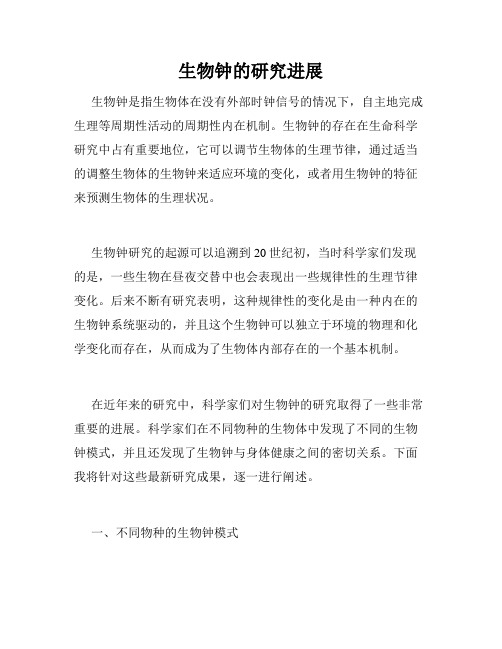
生物钟的研究进展生物钟是指生物体在没有外部时钟信号的情况下,自主地完成生理等周期性活动的周期性内在机制。
生物钟的存在在生命科学研究中占有重要地位,它可以调节生物体的生理节律,通过适当的调整生物体的生物钟来适应环境的变化,或者用生物钟的特征来预测生物体的生理状况。
生物钟研究的起源可以追溯到20世纪初,当时科学家们发现的是,一些生物在昼夜交替中也会表现出一些规律性的生理节律变化。
后来不断有研究表明,这种规律性的变化是由一种内在的生物钟系统驱动的,并且这个生物钟可以独立于环境的物理和化学变化而存在,从而成为了生物体内部存在的一个基本机制。
在近年来的研究中,科学家们对生物钟的研究取得了一些非常重要的进展。
科学家们在不同物种的生物体中发现了不同的生物钟模式,并且还发现了生物钟与身体健康之间的密切关系。
下面我将针对这些最新研究成果,逐一进行阐述。
一、不同物种的生物钟模式科学家们通过对不同物种的生物钟研究,发现了有许多物种都有某种形式的生物钟。
对于哺乳动物来说,它们的生物钟是通过生理节律来实现的。
也就是说,它们的姿态、行为和新陈代谢等方面都会有一定的规律。
而对于昼夜节律的一些较简单生物如动物、植物和微生物等来说,它们的生物钟更像是一种自我维持的状态机制。
它们的增殖、进化、生长等过程存在一定的周期性规律。
二、生物钟与身体健康之间的密切关系生物钟与身体健康之间的联系是一个重要的研究方向。
许多研究表明,生物钟与身体健康之间存在非常密切的关系。
生物钟混乱会导致生物体的代谢紊乱和免疫调节失调,增加糖尿病、乳腺癌和心血管疾病等疾病的风险。
不仅如此,许多研究还表明,生物钟运作不良与情绪疾病的发病率也有极大的关系,比如抑郁症等。
三、使用光线调整生物钟光线是影响生物钟的一个因素。
科学家们发现,光线可以调节人体的睡眠和觉醒。
其中,蓝光具有很强的调节作用。
为此,科学家们研发出了一些使用光线调节生物钟的系统。
这些调节系统可以根据需要同时实现多个频率的闪烁与刺激,从而最大限度地实现生物钟的调节。
节律生物学和生物时钟的研究进展

节律生物学和生物时钟的研究进展人类的生活是有规律的,我们一天中的醒睡时间、进食时间、运动时间都是有节奏的,这是因为我们的身体内部存在着一种生物钟,这种生物钟又叫做“节律生物钟”。
节律生物钟是人体内分泌物质及其他生理活动随时间的规则变化,与人体的生理和行为状态有密切关系。
近年来,节律生物钟和生物时钟的研究取得了一些新的进展,让我们一起来了解一下。
一、历史回顾节律生物钟的研究历史已经超过两个世纪之久。
早在18世纪初,人们便发现植物在不同的日照条件下会产生不同的生长效果。
1930年代初,美国科学家布鲁克斯发现,如果把小鼠放在一天24小时的恒温环境中,它们仍然具有明显的行为节律,这意味着小鼠拥有自己的生物时钟。
1950年代中后期,美国生理学家比尔曼和巴斯兰发现人类体内也存在着一类叫做“时钟基因”的基因,这些基因可以协调人体内分泌系统和代谢系统的功能,从而调节人体的醒睡、进食和运动等节律活动。
二、研究方法最初,科学家们用不同的动物,尤其是昼行性和夜行性动物,来研究节律生物钟。
例如,在摄取动物视网膜上的光信号的控制下,昆虫便能维持自己的节律生物钟。
随着科学技术的进步,研究人员也开始进行人体实验,探究人体内部的节律生物钟。
这些实验主要采用内分泌和代谢物质的分析来测量人体内部生物钟的变化情况,或使用现代磁共振成像技术模拟人体内部的生物节律。
三、生物钟和健康生物节律不正常的人,比如说夜班工作者,有很多身体问题,比如失眠、消化不良和肥胖症等。
许多研究人员都已经发现,夜班工作者的癌症风险比起日间工作者更高。
同时,科学家也已经发现多种慢性疾病也和生物钟不正常有关。
例如,糖尿病患者的血糖控制通常会受到生物钟的影响,失衡的生物钟也被认为是心理性忧郁症的诱因之一。
四、未来发展研究目前,科学家们正在更深入地研究节律生物钟对身体、代谢和行为的控制机制,并进一步探究生物钟与身体健康之间的关系。
近年来,一些新技术已经应用于研究节律生物钟,例如全基因组测序、蛋白质组学技术等,这些技术可以揭示形成和修正基因表达的调控机制,从而深入了解神经、内分泌和代谢系统的相关机制。
生物钟对动物糖脂代谢的影响研究进展

生物钟对动物糖脂代谢的影响研究进展一、内容描述生物钟是生物体内一种自然的节律性现象,它对动物的生活习性、行为活动和生理功能等产生重要影响。
近年来随着研究的深入,科学家们发现生物钟不仅与动物的行为活动密切相关,还对动物糖脂代谢产生显著影响。
本文将对这一研究领域的最新进展进行概述,以期为相关领域的研究提供参考。
首先生物钟对动物能量代谢的影响已经得到了广泛关注,研究表明生物钟可以通过调控动物的食欲、能量摄入和消耗等生理过程,影响动物的能量代谢。
例如一些研究发现,在24小时周期内,动物在早晨和傍晚时的能量摄取量较高,而在白天则较低,这可能与生物钟对动物活动规律的调节有关。
此外生物钟还可以影响动物的脂肪酸合成和分解过程,从而影响脂肪代谢。
其次生物钟对动物糖脂代谢的影响也日益受到重视,糖脂是一类重要的能量储存物质,包括糖原、肌糖原和肝糖原等。
生物钟通过调控动物的糖代谢和脂肪代谢过程,影响糖脂的合成和分解。
例如一些研究发现,生物钟可以通过调节胰岛素分泌、葡萄糖吸收和利用等生理过程,影响动物的血糖水平和糖脂代谢。
此外生物钟还可以影响动物的脂肪酸合成和氧化途径,从而影响脂肪代谢。
生物钟对动物糖脂代谢的影响机制尚未完全阐明,目前的研究主要集中在以下几个方面:一是探讨生物钟与激素信号通路的关系,如胰岛素、瘦素、褪黑素等;二是研究生物钟与神经递质的关系,如GABA、去甲肾上腺素等;三是研究生物钟与其他环境因素的关系,如光照、温度等。
这些研究有助于我们更深入地了解生物钟对动物糖脂代谢的影响机制,为相关疾病的防治提供理论依据。
1. 生物钟的定义和作用生物钟也被称为昼夜节律或生理钟,是生物体内的一种自然调节机制,负责调控生物体在24小时内的生理活动和行为。
这个机制通过与环境光照周期同步,使生物体在一天中的不同时间段对某些刺激产生特定的反应。
这种现象在所有生物中都有出现,从细菌到哺乳动物,甚至是人类。
生物钟的作用广泛且复杂,它影响许多生理过程,包括睡眠觉醒、能量代谢、荷尔蒙分泌和免疫系统功能等。
生物钟与生物节律的研究进展
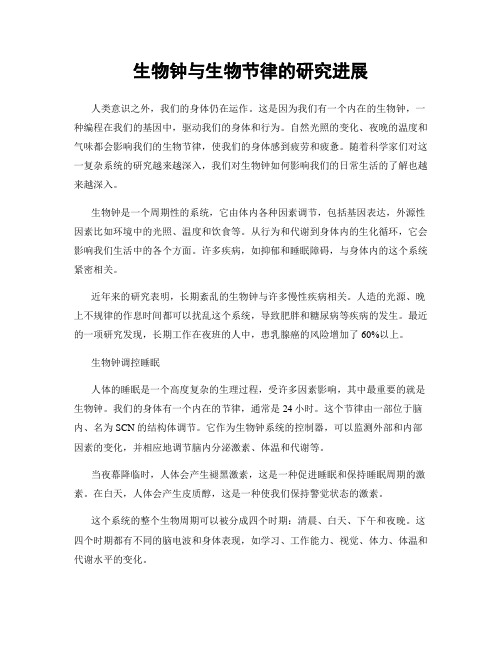
生物钟与生物节律的研究进展人类意识之外,我们的身体仍在运作。
这是因为我们有一个内在的生物钟,一种编程在我们的基因中,驱动我们的身体和行为。
自然光照的变化、夜晚的温度和气味都会影响我们的生物节律,使我们的身体感到疲劳和疲惫。
随着科学家们对这一复杂系统的研究越来越深入,我们对生物钟如何影响我们的日常生活的了解也越来越深入。
生物钟是一个周期性的系统,它由体内各种因素调节,包括基因表达,外源性因素比如环境中的光照、温度和饮食等。
从行为和代谢到身体内的生化循环,它会影响我们生活中的各个方面。
许多疾病,如抑郁和睡眠障碍,与身体内的这个系统紧密相关。
近年来的研究表明,长期紊乱的生物钟与许多慢性疾病相关。
人造的光源、晚上不规律的作息时间都可以扰乱这个系统,导致肥胖和糖尿病等疾病的发生。
最近的一项研究发现,长期工作在夜班的人中,患乳腺癌的风险增加了60%以上。
生物钟调控睡眠人体的睡眠是一个高度复杂的生理过程,受许多因素影响,其中最重要的就是生物钟。
我们的身体有一个内在的节律,通常是24小时。
这个节律由一部位于脑内、名为 SCN 的结构体调节。
它作为生物钟系统的控制器,可以监测外部和内部因素的变化,并相应地调节脑内分泌激素、体温和代谢等。
当夜幕降临时,人体会产生褪黑激素,这是一种促进睡眠和保持睡眠周期的激素。
在白天,人体会产生皮质醇,这是一种使我们保持警觉状态的激素。
这个系统的整个生物周期可以被分成四个时期:清晨、白天、下午和夜晚。
这四个时期都有不同的脑电波和身体表现,如学习、工作能力、视觉、体力、体温和代谢水平的变化。
总的来说,我们的身体需要遵循这个循环来维持一个良好的代谢状态,以帮助我们保持健康状态。
生物钟调控代谢有许多与代谢变化相关的生物钟发现,这些发现表明身体的节律与许多疾病的发病有关。
其中最突出的是糖尿病,这是一个广泛的代谢性疾病,它与生物节律的紊乱有很大的关系。
研究表明,夜班工作和慢性睡眠不足都可能导致糖尿病,而根据患者的生物钟特征,定制化的糖尿病治疗不仅可以提高治疗效果,还可以减少不必要的副作用。
生物钟的探索与研究进展
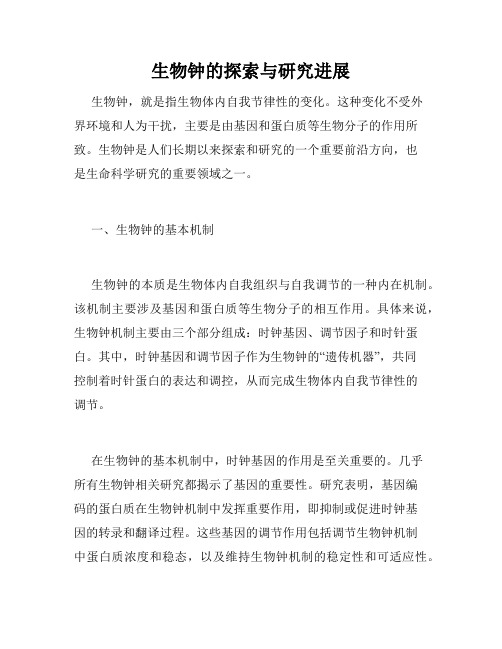
生物钟的探索与研究进展生物钟,就是指生物体内自我节律性的变化。
这种变化不受外界环境和人为干扰,主要是由基因和蛋白质等生物分子的作用所致。
生物钟是人们长期以来探索和研究的一个重要前沿方向,也是生命科学研究的重要领域之一。
一、生物钟的基本机制生物钟的本质是生物体内自我组织与自我调节的一种内在机制。
该机制主要涉及基因和蛋白质等生物分子的相互作用。
具体来说,生物钟机制主要由三个部分组成:时钟基因、调节因子和时针蛋白。
其中,时钟基因和调节因子作为生物钟的“遗传机器”,共同控制着时针蛋白的表达和调控,从而完成生物体内自我节律性的调节。
在生物钟的基本机制中,时钟基因的作用是至关重要的。
几乎所有生物钟相关研究都揭示了基因的重要性。
研究表明,基因编码的蛋白质在生物钟机制中发挥重要作用,即抑制或促进时钟基因的转录和翻译过程。
这些基因的调节作用包括调节生物钟机制中蛋白质浓度和稳态,以及维持生物钟机制的稳定性和可适应性。
此外,还存在一些与生物钟相关的影响因素,如灯光、代谢、温度和干扰等。
这些因素都可能直接或间接影响生物钟机制的运作,从而导致生物体内节律性的改变。
例如,光线暴露可以直接调整人体内的生物钟,促进我们的睡眠和醒来时间。
另外,运动和饮食习惯、社交和工作压力等都会对个体的内在生物节律性产生影响,进一步影响生物体的健康和生活质量。
二、生物钟的历史早在1644年,法国数学家和发明家Pierre de Fermat就提出了生物钟中“最小路线”问题。
很长一段时间,人们对生物钟只有简单的认知,即生物体的生理节奏有其自身规律性。
直到20世纪初期,生物学家才开始深入探究生物钟的作用和机制。
此后,生物钟的相关研究逐渐成为生命科学领域的重要研究方向。
二战期间,美国空军飞行员在长时间飞行中发现,他们的机体内部出现了某种失调状态。
这一现象引起了生物学家的广泛关注,进而成为了生物钟研究中的重要课题。
20世纪40年代和50年代,生物学家开始通过肾上腺素和甲状腺素等激素物质的作用,探究生物钟的作用和机理。
人类生物钟的发现和研究历程
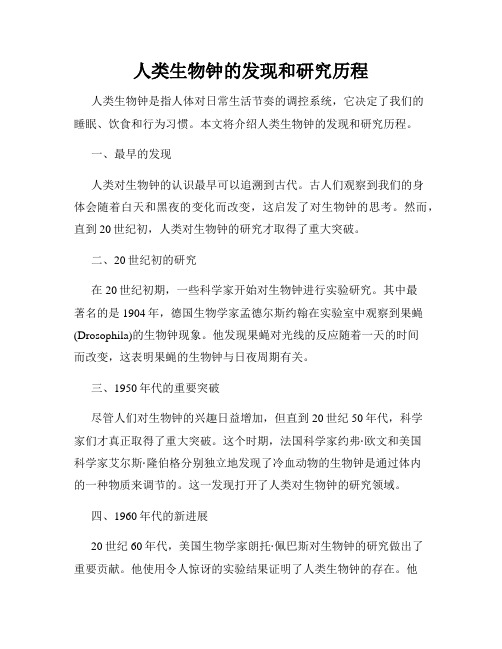
人类生物钟的发现和研究历程人类生物钟是指人体对日常生活节奏的调控系统,它决定了我们的睡眠、饮食和行为习惯。
本文将介绍人类生物钟的发现和研究历程。
一、最早的发现人类对生物钟的认识最早可以追溯到古代。
古人们观察到我们的身体会随着白天和黑夜的变化而改变,这启发了对生物钟的思考。
然而,直到20世纪初,人类对生物钟的研究才取得了重大突破。
二、20世纪初的研究在20世纪初期,一些科学家开始对生物钟进行实验研究。
其中最著名的是1904年,德国生物学家孟德尔斯约翰在实验室中观察到果蝇(Drosophila)的生物钟现象。
他发现果蝇对光线的反应随着一天的时间而改变,这表明果蝇的生物钟与日夜周期有关。
三、1950年代的重要突破尽管人们对生物钟的兴趣日益增加,但直到20世纪50年代,科学家们才真正取得了重大突破。
这个时期,法国科学家约弗·欧文和美国科学家艾尔斯·隆伯格分别独立地发现了冷血动物的生物钟是通过体内的一种物质来调节的。
这一发现打开了人类对生物钟的研究领域。
四、1960年代的新进展20世纪60年代,美国生物学家朗托·佩巴斯对生物钟的研究做出了重要贡献。
他使用令人惊讶的实验结果证明了人类生物钟的存在。
他将一群志愿者放置在一个没有时间线索的洞穴中,发现这些人的生物节奏开始逐渐脱离常规的24小时周期,他们的身体逐渐形成了一种近25小时的自然周期。
这一实验结果揭示了人类生物钟的真实性,并引起了广泛的关注。
五、1970年代以后的深入研究进入20世纪70年代,人们对生物钟的研究进一步深入。
科学家们通过动物和人类的实验,揭示了更多关于生物钟的信息。
他们发现生物钟与体内的生物节律、遗传等因素有关。
同时,科学家们还开始研究生物钟对人体健康的影响,如睡眠障碍、抑郁症等。
六、21世纪的前沿领域进入21世纪,科学家们的研究重点逐渐转向了更加深入的领域。
他们开始探究生物钟如何通过对基因的调控来实现对生物节律的掌控。
生物钟的研究 功能和机理 度诺贝尔生理学或医学奖成果简析

诺贝尔生理学或医学奖成果分析
2017年诺贝尔生理学或医学奖颁给了三位杰出的科学家,以表彰他们在对生物 钟的研究中所做出的卓越贡献。其中,一位科学家发现了生物钟的基因基础, 揭示了基因表达和信号转导的奥秘;另一位科学家则揭示了生物钟在调节生理 代谢和激素水平方面的作用;最后一位科学家发现了生物钟的染色体机制,为 理解生物钟在睡眠节律调控中的作用提供了重要线索。
这三位科学家的研究成果对于理解生物钟的重要性和意义具有极其重要的价值。 他们的研究不仅揭示了生物钟的内在机制,还阐明了生物钟在调节生理代谢、 激素水平和睡眠节律等方面的作用。这些成果为我们提供了更为深入的认识, 有助于我们更好地理解生物体的节律性,并为相关领域的研究提供了重要的理 论基础。
结论
生物钟在生物学领域中具有非常重要的地位,它对于生理健康和疾病治疗具有 重要意义。通过对生物钟的研究、功能和机理的深入了解,我们可以更好地认 识生物体的节律性,并为相关领域的研究提供有益的启示。
生物钟机理
生物钟的机理主要包括基因表达、信号转导和染色体机制等方面。首先,生物 钟的基因表达具有周期性,它受到光信号和内部时钟的调控。这些基因的表达 产物可以与相应的蛋白质结合,形成复合物,进而调节其他基因的表达。其次, 信号转导在生物钟中也发挥了重要作用。例如,光信号可以激活视网膜特殊受 体,进而调控生物钟基因表达。最后,染色体机制也是生物钟的重要环节。
生物钟研究
生物钟,也称为生物节律,是指生物体在自然界中存在的周期性节律。它包括 外貌、内在机制和不同物种间的差异等方面。生物钟的研究历史可以追溯到18 世纪,当时科学家们已经注意到生物体存在着周期性的活动。随着科学技术的 不断发展,科学家们逐渐揭示了生物钟的内在机制。
生物钟功能
生物钟基因的一些非生物钟效应研究进展
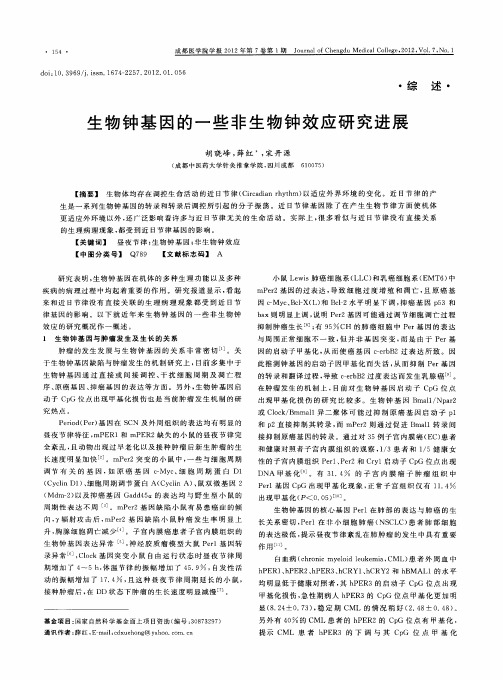
疾 病 的病 理 过程 中 均 起着 重要 的作 用 。研 究 报 道 显 示 , 看起
小 鼠 L wi 肺 癌 细 胞 系 ( I ) e s L 和乳 癌 细胞 系 ( MT6 中 C E )
mP r 因 的 过 表 达 , 致 细 胞 过 度 增 殖 和 凋 亡 , 原 癌 基 e2基 导 且
的生 理 病 理 现 象 , 受 到近 日节 律 基 因 的影 响 。 都 【 键 词】 昼 夜 节 律 ; 物 钟 基 因 ; 生 物钟 效应 关 生 非
【 图 分 类 号】 Q7 9 中 8 【 献标 志码 】 A 文
研 究 表 明 , 物 钟 基 因 在 机 体 的 多 种 生 理 功 能 以及 多种 生
成都医学院学报 2 1 0 2年 第 7卷 第 1 期
J u n l fC e g u Me i l o l e 2 1 , 1 7 No 1 o r a o h n d dc l g ,0 2 Vo. , . aC e
・
综 述 ・
生 物 钟 基 因 的 一 些 非 生 物 钟 效 应 研 究 进 展
来 和 近 日节 律 没 有 直 接 关 联 的 生 理 病 理 现 象 都 受 到 近 日节
律 基 因 的 影 响 。 以 下 就 近 年 来 生 物 钟 基 因 的 一 些 非 生 物 钟 效应的研究概况作一概述 。 1 生物 钟 基 因 与肿 瘤 发 生及 生长 的关 系
生物钟基因与肿瘤时辰治疗的研究进展

2 6 2 2・
熊
娟, 等
生物钟基 因与肿瘤时辰治疗的研究进展
ቤተ መጻሕፍቲ ባይዱ
生 物钟 基 因与肿 瘤 时辰 治 疗 的研 究进 展
熊 娟 , 李光 明
R e s e a r c h a d v a n c e s o f c i r c a d i a n c l o c k g e n e s a n d c h r o n n o t h e r a p y
c i r c a d i a n r h y t h ms i n t u mo r d e v e l o p me n t , g r o w t h a n d me t a s t a s i s . C i r c a d i a n c l o c k g e n e s , w i d e s p r e a d i n t h e b i o s p h e r e , a l e t h e mo l e c u l a r b si a s o f b i o l o g i c a l c i r c a d i n a r h y t h m. I t C n a a c c e l e r a t e t h e g r o wt h a n d me t a s t a s i s o f t u mo r wh e n t h e
【 关键词 】 生物钟基 因 ; 肿瘤 ; 时辰化疗 ; 时辰放 疗 【 中图分类号 】 R 7 3 0 . 5 【 文献标识码】 A D O I : 1 0 . 3 9 6 9 / j . i s s n . 1 6 7 2 — 4 9 9 2 . 2 0 1 3 . 1 1 . 7 4
Mo d e m O n c o l o g y 2 0 1 3 , 2 1 ( 1 1 ) : 2 6 2 2 —2 6 2 5
生物钟研究的新进展与新策略
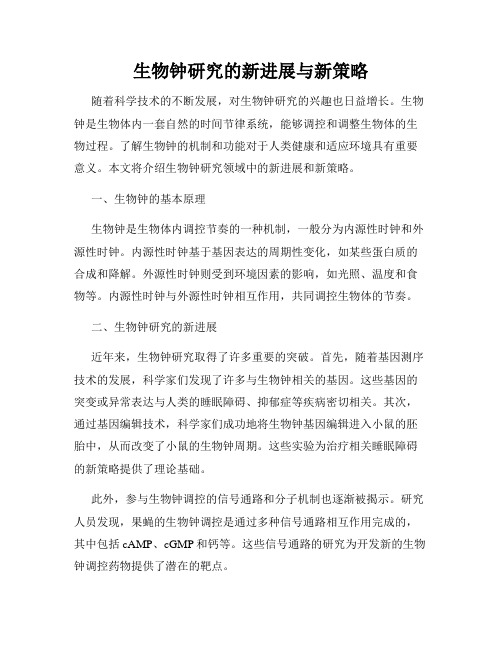
生物钟研究的新进展与新策略随着科学技术的不断发展,对生物钟研究的兴趣也日益增长。
生物钟是生物体内一套自然的时间节律系统,能够调控和调整生物体的生物过程。
了解生物钟的机制和功能对于人类健康和适应环境具有重要意义。
本文将介绍生物钟研究领域中的新进展和新策略。
一、生物钟的基本原理生物钟是生物体内调控节奏的一种机制,一般分为内源性时钟和外源性时钟。
内源性时钟基于基因表达的周期性变化,如某些蛋白质的合成和降解。
外源性时钟则受到环境因素的影响,如光照、温度和食物等。
内源性时钟与外源性时钟相互作用,共同调控生物体的节奏。
二、生物钟研究的新进展近年来,生物钟研究取得了许多重要的突破。
首先,随着基因测序技术的发展,科学家们发现了许多与生物钟相关的基因。
这些基因的突变或异常表达与人类的睡眠障碍、抑郁症等疾病密切相关。
其次,通过基因编辑技术,科学家们成功地将生物钟基因编辑进入小鼠的胚胎中,从而改变了小鼠的生物钟周期。
这些实验为治疗相关睡眠障碍的新策略提供了理论基础。
此外,参与生物钟调控的信号通路和分子机制也逐渐被揭示。
研究人员发现,果蝇的生物钟调控是通过多种信号通路相互作用完成的,其中包括cAMP、cGMP和钙等。
这些信号通路的研究为开发新的生物钟调控药物提供了潜在的靶点。
三、新策略:光照调控生物钟近年来,研究人员开始尝试利用光照来调控生物钟。
光照是外源性时钟的主要刺激源,通过调节光照的强度和时长,可以调整生物体的节律。
光照调控生物钟的新策略主要包括以下几个方面:1. 光照定时调节:调节光照的强度和时长以模拟自然界的昼夜变化。
这种方法可以帮助人们调整自己的生物钟,提高生理和心理的健康水平。
2. 蓝光照射:研究发现,蓝光对生物钟的调控作用最为显著。
在夜间照射适量的蓝光可以减少人类的睡眠障碍和抑郁症风险。
这种新策略为治疗相关疾病提供了新的思路。
3. 光照节奏调节:光照的强度和时长可以调节生物体的节奏,包括饮食节奏、运动节奏等。
人类生物钟研究与应用
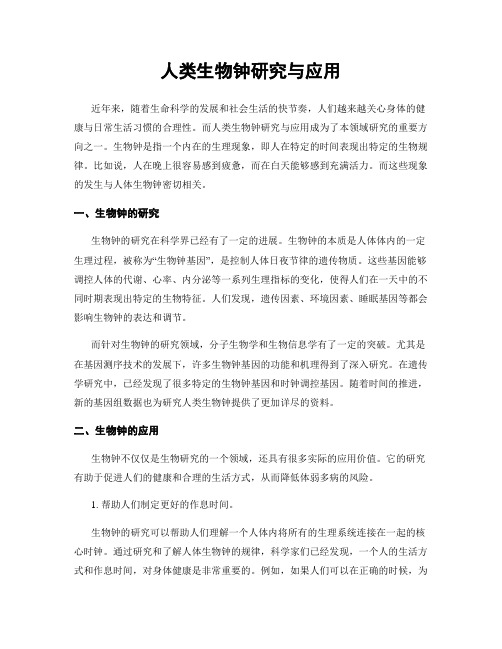
人类生物钟研究与应用近年来,随着生命科学的发展和社会生活的快节奏,人们越来越关心身体的健康与日常生活习惯的合理性。
而人类生物钟研究与应用成为了本领域研究的重要方向之一。
生物钟是指一个内在的生理现象,即人在特定的时间表现出特定的生物规律。
比如说,人在晚上很容易感到疲惫,而在白天能够感到充满活力。
而这些现象的发生与人体生物钟密切相关。
一、生物钟的研究生物钟的研究在科学界已经有了一定的进展。
生物钟的本质是人体体内的一定生理过程,被称为“生物钟基因”,是控制人体日夜节律的遗传物质。
这些基因能够调控人体的代谢、心率、内分泌等一系列生理指标的变化,使得人们在一天中的不同时期表现出特定的生物特征。
人们发现,遗传因素、环境因素、睡眠基因等都会影响生物钟的表达和调节。
而针对生物钟的研究领域,分子生物学和生物信息学有了一定的突破。
尤其是在基因测序技术的发展下,许多生物钟基因的功能和机理得到了深入研究。
在遗传学研究中,已经发现了很多特定的生物钟基因和时钟调控基因。
随着时间的推进,新的基因组数据也为研究人类生物钟提供了更加详尽的资料。
二、生物钟的应用生物钟不仅仅是生物研究的一个领域,还具有很多实际的应用价值。
它的研究有助于促进人们的健康和合理的生活方式,从而降低体弱多病的风险。
1. 帮助人们制定更好的作息时间。
生物钟的研究可以帮助人们理解一个人体内将所有的生理系统连接在一起的核心时钟。
通过研究和了解人体生物钟的规律,科学家们已经发现,一个人的生活方式和作息时间,对身体健康是非常重要的。
例如,如果人们可以在正确的时候,为身体提供合适的能量,那么将对健康起到积极的促进作用。
同时适当控制自己的生活作息,不进行过度劳累,也可以减少疾病的风险。
2. 改善夜班工作人员的生活质量。
对于一些职业而言,特别是那些需要工作在夜班的人员,生物钟的研究有重要的应用价值。
对于这些人员来说,在白天保证充足的睡眠、饮食和心态都可以帮助他们更好地适应夜班。
人类时钟基因的研究进展
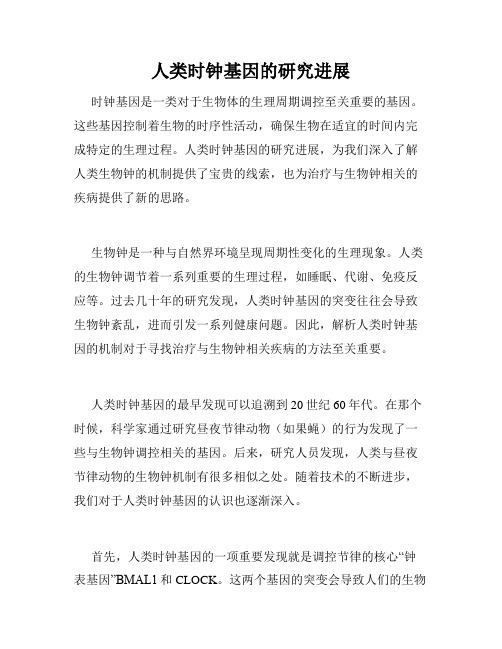
人类时钟基因的研究进展时钟基因是一类对于生物体的生理周期调控至关重要的基因。
这些基因控制着生物的时序性活动,确保生物在适宜的时间内完成特定的生理过程。
人类时钟基因的研究进展,为我们深入了解人类生物钟的机制提供了宝贵的线索,也为治疗与生物钟相关的疾病提供了新的思路。
生物钟是一种与自然界环境呈现周期性变化的生理现象。
人类的生物钟调节着一系列重要的生理过程,如睡眠、代谢、免疫反应等。
过去几十年的研究发现,人类时钟基因的突变往往会导致生物钟紊乱,进而引发一系列健康问题。
因此,解析人类时钟基因的机制对于寻找治疗与生物钟相关疾病的方法至关重要。
人类时钟基因的最早发现可以追溯到20世纪60年代。
在那个时候,科学家通过研究昼夜节律动物(如果蝇)的行为发现了一些与生物钟调控相关的基因。
后来,研究人员发现,人类与昼夜节律动物的生物钟机制有很多相似之处。
随着技术的不断进步,我们对于人类时钟基因的认识也逐渐深入。
首先,人类时钟基因的一项重要发现就是调控节律的核心“钟表基因”BMAL1和CLOCK。
这两个基因的突变会导致人们的生物钟完全失调。
BMAL1和CLOCK的蛋白质产物能够结合成复合物,启动一系列下游基因的表达,从而调控生物节律的生成和维持。
近年来的研究还发现,BMAL1和CLOCK与多种疾病相关,如肿瘤、心脑血管疾病等,这为进一步探讨生物钟与疾病之间的关系提供了新的切入点。
其次,人类时钟基因的研究还揭示了许多与社会行为节律相关的基因。
例如,PER1和PER2基因通过调控脑部神经元活动,影响睡眠周期和精神状态。
人类的社会行为节律与生理节律密切相关,因此,通过研究这些基因能够帮助我们更好地理解人类的行为习惯和心理健康。
此外,人类时钟基因的研究还向我们揭示了与年龄相关的生物钟变化。
随着年龄的增长,人体的生物钟逐渐迟缓,导致许多老年人出现失眠、抑郁等问题。
对于老年人的生活质量和健康管理来说,了解和干预人类时钟基因的变化具有重要意义。
生物钟研究进展
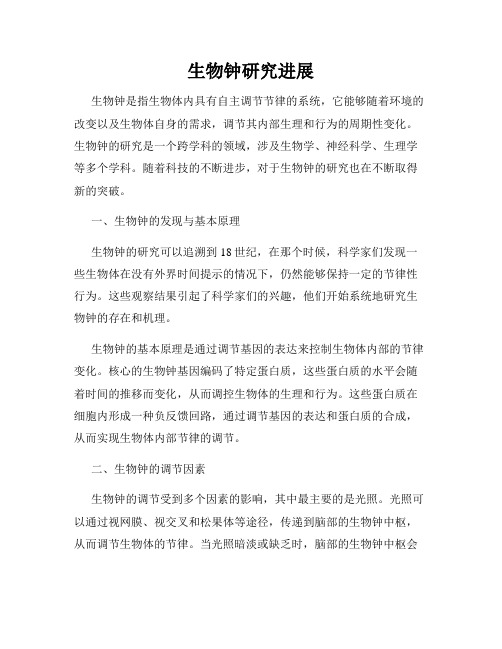
生物钟研究进展生物钟是指生物体内具有自主调节节律的系统,它能够随着环境的改变以及生物体自身的需求,调节其内部生理和行为的周期性变化。
生物钟的研究是一个跨学科的领域,涉及生物学、神经科学、生理学等多个学科。
随着科技的不断进步,对于生物钟的研究也在不断取得新的突破。
一、生物钟的发现与基本原理生物钟的研究可以追溯到18世纪,在那个时候,科学家们发现一些生物体在没有外界时间提示的情况下,仍然能够保持一定的节律性行为。
这些观察结果引起了科学家们的兴趣,他们开始系统地研究生物钟的存在和机理。
生物钟的基本原理是通过调节基因的表达来控制生物体内部的节律变化。
核心的生物钟基因编码了特定蛋白质,这些蛋白质的水平会随着时间的推移而变化,从而调控生物体的生理和行为。
这些蛋白质在细胞内形成一种负反馈回路,通过调节基因的表达和蛋白质的合成,从而实现生物体内部节律的调节。
二、生物钟的调节因素生物钟的调节受到多个因素的影响,其中最主要的是光照。
光照可以通过视网膜、视交叉和松果体等途径,传递到脑部的生物钟中枢,从而调节生物体的节律。
当光照暗淡或缺乏时,脑部的生物钟中枢会释放一种叫做"褪黑激素"的化学物质,通过血液循环到达全身各个部位,从而调节生物体的节律。
除了光照之外,环境因素、温度、食物和社会活动等也会影响生物钟的节律性。
这些因素可以通过影响生物体内部的代谢和行为来调节生物钟的节律。
三、生物钟与人类健康生物钟对于人类的健康具有重要的影响。
不良的生物钟节律会导致睡眠障碍、精神压力和免疫功能下降等问题。
而良好的生物钟节律可以提高睡眠质量、增强免疫力和调节情绪。
随着对生物钟的研究不断深入,人们逐渐认识到了生物钟调节的重要性,并开始提倡合理调整作息时间、控制光照环境等方式来维护良好的生物钟节律。
此外,生物钟的研究为一些重大疾病的治疗提供了新的思路,如睡眠障碍和慢性疼痛等。
四、生物钟研究的前景与挑战生物钟研究的前景非常广阔,它不仅可以提高我们对于生物体节律性行为的理解,还可以为制定人类作息时间、预测疾病发生和治疗等方面提供指导。
生物钟基因NPAS2的研究进展
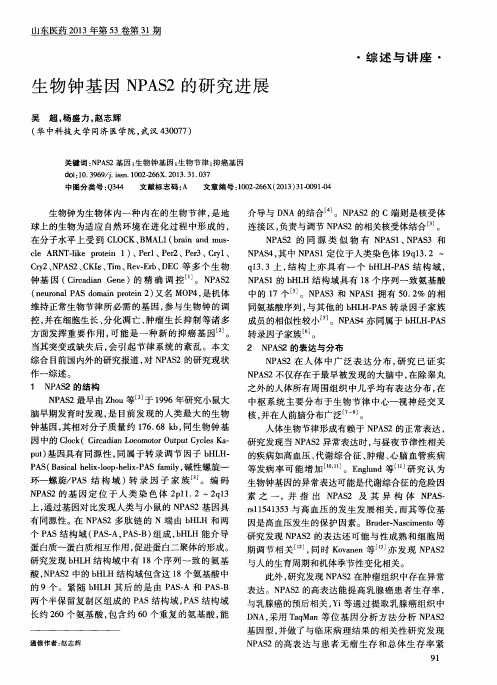
N P A S 2在 人 体 中 广 泛 表 达 分 布 , 研 究 已 证 实
N P A S 2 不仅存在于最早被发现 的大脑 中, 在除睾丸 之外 的人 体所有 周 围组 织 中几 乎 均 有 表 达分 布 , 在 中枢系统主要分布 于生物节律 中心一视神经交叉
d o i : 1 0 . 3 9 6 9 / j . i s s n . 1 0 0 2 - 2 6 6 X . 2 0 1 3 . 3 1 . 0 3 7
中 图分 类 号 : Q 3 4 4
文 献 标 志码 : A
文章编 号 : 1 0 0 2 - 2 6 6 x( 2 0 1 3 ) 3 1 - 0 0 9 1 - 0 4
有 同源 性 。在 N P A S 2多 肽 链 的 N 端 由 b H L H 和 两 个P A S结 构 域 ( P A S — A, P A S . B) 组成 , b H L H 能 介 导 蛋 白质一 蛋 白质 相互作 用 , 促进 蛋 白二 聚体 的形成 。 研 究发 现 b H L H结 构 域 中有 1 8个 序 列 一 致 的 氨 基 酸, N P A S 2中 的 b HL H结 构域 包含 这 1 8个氨 基酸 中
生物 钟 为生物 体 内一 种 内在 的 生 物 节律 , 是地 球上 的生 物 为适应 自然 环境 在 进 化 过 程 中形 成 的 , 在分 子水 平 上 受 到 C L O C K、 B MA L 1 ( b r a i n a n d m u s .
c l e A R N T — l i k e p r o t e i n 1 ) 、 P e r l 、 P e r 2 、 P e r 3 、 C r y l 、
植物生物钟研究的历史回顾与最新进展

植物生物钟研究的历史回顾与最新进展徐小冬;谢启光【摘要】Circadian clock generates endogenous rhythms to confer the fitness advantages for most organisms. Plants with the evolved self-sustaining rhythms could anticipate the changes of environment, synchronize own growth and development with oscillated outer signals. This review summarizes the emerging of research work on the various circadian rhythms, introduces the concepts of chronobiology and related theory, etc, and describes in detail on the current basic network architecture of circadian systems of higher plants, including the prominent transcriptional and posttranslational mechanism.%生物钟几乎参与调控了植物体所有的新陈代谢、生长发育过程,使植物体与外界环境条件达到时间和空间的同步,极大地增强了植物环境适应性和竞争能力.笔者首先从植物生物钟的研究历史入手,回顾了中国古代农业生产中对节律性的认识和应用;然后介绍了现代植物生物钟研究的起源、基本概念和理论知识;最后重点论述了本领域的最新研究进展,揭示了植物生物钟作为复杂的信号转导网络的“整体水平”调控特性和“牵一发而动全身”的独特性.【期刊名称】《自然杂志》【年(卷),期】2013(035)002【总页数】9页(P118-126)【关键词】生物钟;周期节律;时间生物学;植物【作者】徐小冬;谢启光【作者单位】达特茅斯大学生物系,美国新罕布什尔州汉诺威03755【正文语种】中文在生命漫长的发展历程里,由自然选择主导的进化长河中,诸多种类的生命体殊途同归,演化和发展出了可以称得上生命基本特征之一的周期节律性。
生物钟的研究进展
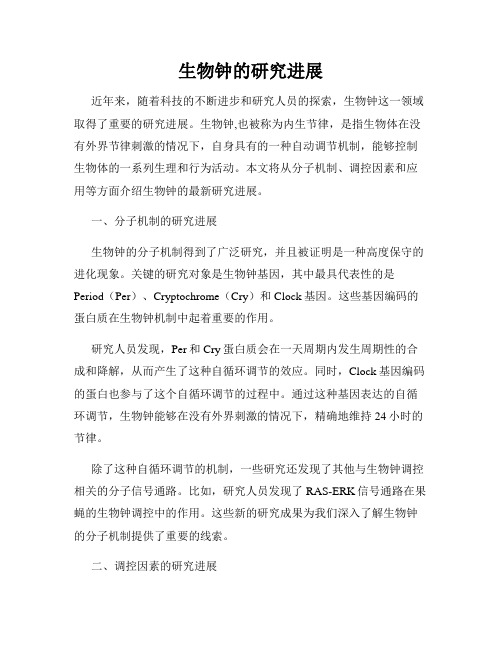
生物钟的研究进展近年来,随着科技的不断进步和研究人员的探索,生物钟这一领域取得了重要的研究进展。
生物钟,也被称为内生节律,是指生物体在没有外界节律刺激的情况下,自身具有的一种自动调节机制,能够控制生物体的一系列生理和行为活动。
本文将从分子机制、调控因素和应用等方面介绍生物钟的最新研究进展。
一、分子机制的研究进展生物钟的分子机制得到了广泛研究,并且被证明是一种高度保守的进化现象。
关键的研究对象是生物钟基因,其中最具代表性的是Period(Per)、Cryptochrome(Cry)和Clock基因。
这些基因编码的蛋白质在生物钟机制中起着重要的作用。
研究人员发现,Per和Cry蛋白质会在一天周期内发生周期性的合成和降解,从而产生了这种自循环调节的效应。
同时,Clock基因编码的蛋白也参与了这个自循环调节的过程中。
通过这种基因表达的自循环调节,生物钟能够在没有外界刺激的情况下,精确地维持24小时的节律。
除了这种自循环调节的机制,一些研究还发现了其他与生物钟调控相关的分子信号通路。
比如,研究人员发现了RAS-ERK信号通路在果蝇的生物钟调控中的作用。
这些新的研究成果为我们深入了解生物钟的分子机制提供了重要的线索。
二、调控因素的研究进展生物钟的调控不仅仅受到基因的影响,还受到一系列内外环境因素的调控。
研究人员对于这些调控因素进行了广泛的研究,包括光照、温度、饮食、社交生活等。
在研究光照调控方面,研究人员发现,生物钟的调节与光照强度和谱线密切相关。
光照强度和谱线的改变都会对生物钟的节律产生影响。
此外,光照强度和谱线也被证明可以调节生物钟基因的表达水平。
温度也是一种常见的生物钟调控因素。
研究人员发现,温度的变化可以影响生物钟的周期,进而改变生物体的活动节律。
温度对于生物钟的调控机制还在进一步的研究中。
此外,饮食和社交生活等因素也与生物钟的调节密切相关。
不同的饮食结构和社交生活方式都会对生物钟产生影响,进而影响生物体的生理活动。
生物钟研究的发展与应用

生物钟研究的发展与应用随着人类社会的发展,越来越多的人开始关注健康和生活方式,其中包括睡眠和睡眠质量。
而生物钟研究的发展和应用,正是对人们睡眠规律和健康影响方面的探索和解决。
一、生物钟的发现生物钟最早被发现是在1729年,法国地质学家Maurice Bonnefoy睡过头错过了他的毕业典礼,他从此开始研究为什么会产生这种奇怪的现象。
但是真正对生物钟进行研究和发现的是另外两位科学家Jürgen Aschoff 和 Erwin Bünning。
他们是20世纪的两位德国生物学家,一起在20世纪30年代发现了真正的生物钟,证明了它们是一种内在的机制。
二、生物钟的控制对于生物钟的控制,是与地球自转周期的关系密切相关的。
全球上下每个地方的昼夜变化与地球自转周期一致。
但是地球的自转周期是不断变化的,所以不同的季节里昼夜长短也不同。
而生物钟却不会被自然的昼夜节律规则所左右,它是由人体内生物钟基因所驱动的,这套基因控制着人类身体精细的节律和昼夜活动规律。
三、生物钟的调整当人们的生物钟被打乱时,例如长时间的对着电脑,整晚不睡觉或是工作的夜班等。
身体的大多数功能均会受到影响。
身体内各种生物学过程的节律,会被打乱并且长时间偏离正常节律。
此时,人类便会出现很多疾病,例如失眠、抑郁症、压力、心脏病、癌症等等。
所以,当人们的生物钟被打乱时,应及时调整和纠正生活方式。
四、生物钟的应用生物钟的发展和应用,在医疗、食品、农业、生产技术等方面都具有重要的现实意义。
生物钟研究在现代药物领域已经成为了一个前沿领域,对于药物的剂量、定时和效果等,都有着深刻的影响。
生物钟研究对于食品领域也具有重要的意义。
例如柑橘类水果在早上采摘可以得到更好的口感,而在晚上采摘后果味会变得发硬。
通过利用生物钟的规律可以在早上采摘,能够获得更好、更甜的柑橘类水果。
生物钟研究还可以在农业领域应用,通过掌握农作物生物钟的规律,为农业人员的作业计划提供科学依据,从而提高农作物的产量和质量。
昆虫生物钟研究的进展及应用
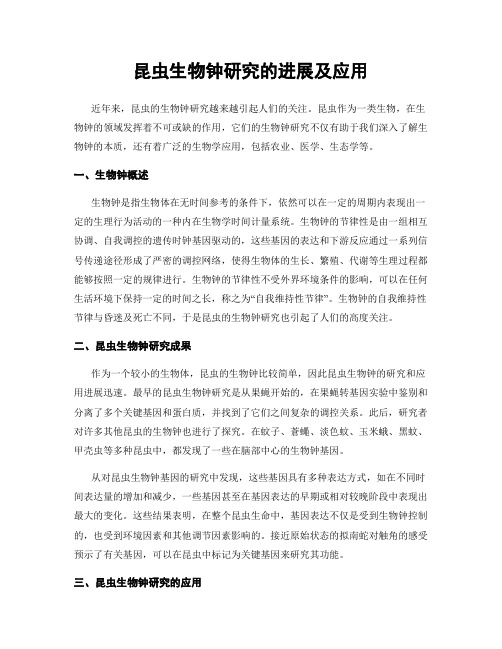
昆虫生物钟研究的进展及应用近年来,昆虫的生物钟研究越来越引起人们的关注。
昆虫作为一类生物,在生物钟的领域发挥着不可或缺的作用,它们的生物钟研究不仅有助于我们深入了解生物钟的本质,还有着广泛的生物学应用,包括农业、医学、生态学等。
一、生物钟概述生物钟是指生物体在无时间参考的条件下,依然可以在一定的周期内表现出一定的生理行为活动的一种内在生物学时间计量系统。
生物钟的节律性是由一组相互协调、自我调控的遗传时钟基因驱动的,这些基因的表达和下游反应通过一系列信号传递途径形成了严密的调控网络,使得生物体的生长、繁殖、代谢等生理过程都能够按照一定的规律进行。
生物钟的节律性不受外界环境条件的影响,可以在任何生活环境下保持一定的时间之长,称之为“自我维持性节律”。
生物钟的自我维持性节律与昏迷及死亡不同,于是昆虫的生物钟研究也引起了人们的高度关注。
二、昆虫生物钟研究成果作为一个较小的生物体,昆虫的生物钟比较简单,因此昆虫生物钟的研究和应用进展迅速。
最早的昆虫生物钟研究是从果蝇开始的,在果蝇转基因实验中鉴别和分离了多个关键基因和蛋白质,并找到了它们之间复杂的调控关系。
此后,研究者对许多其他昆虫的生物钟也进行了探究。
在蚊子、蒼蠅、淡色蚊、玉米蛾、黑蚊、甲壳虫等多种昆虫中,都发现了一些在脑部中心的生物钟基因。
从对昆虫生物钟基因的研究中发现,这些基因具有多种表达方式,如在不同时间表达量的增加和减少,一些基因甚至在基因表达的早期或相对较晚阶段中表现出最大的变化。
这些结果表明,在整个昆虫生命中,基因表达不仅是受到生物钟控制的,也受到环境因素和其他调节因素影响的。
接近原始状态的拟南蛇对触角的感受预示了有关基因,可以在昆虫中标记为关键基因来研究其功能。
三、昆虫生物钟研究的应用昆虫的生物钟研究不仅能深化我们对生物钟的基础知识的理解,也有着重大的实际应用。
口腔颌面昆虫在昼夜的生物钟系统中起重要作用,这为医学研究提供了有价值的线索。
比如,熬夜经常加班的人容易造成昼夜节律混乱,导致身体产生一系列的“昼夜本系统障碍”,影响人们的身心健康。
时间生物学生物钟机制与调控因子研究
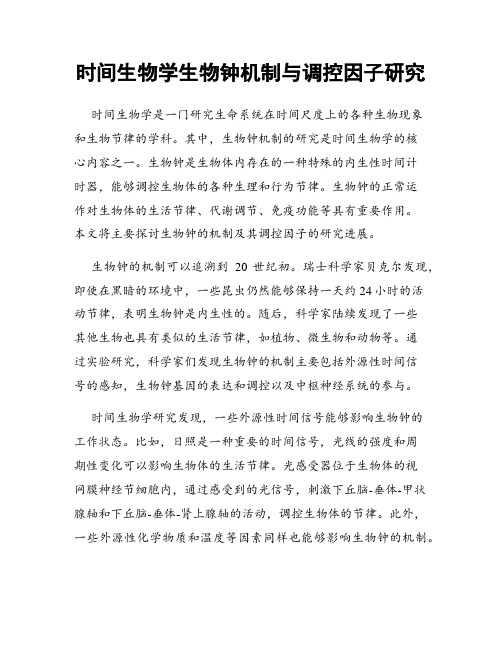
时间生物学生物钟机制与调控因子研究时间生物学是一门研究生命系统在时间尺度上的各种生物现象和生物节律的学科。
其中,生物钟机制的研究是时间生物学的核心内容之一。
生物钟是生物体内存在的一种特殊的内生性时间计时器,能够调控生物体的各种生理和行为节律。
生物钟的正常运作对生物体的生活节律、代谢调节、免疫功能等具有重要作用。
本文将主要探讨生物钟的机制及其调控因子的研究进展。
生物钟的机制可以追溯到20世纪初。
瑞士科学家贝克尔发现,即使在黑暗的环境中,一些昆虫仍然能够保持一天约24小时的活动节律,表明生物钟是内生性的。
随后,科学家陆续发现了一些其他生物也具有类似的生活节律,如植物、微生物和动物等。
通过实验研究,科学家们发现生物钟的机制主要包括外源性时间信号的感知,生物钟基因的表达和调控以及中枢神经系统的参与。
时间生物学研究发现,一些外源性时间信号能够影响生物钟的工作状态。
比如,日照是一种重要的时间信号,光线的强度和周期性变化可以影响生物体的生活节律。
光感受器位于生物体的视网膜神经节细胞内,通过感受到的光信号,刺激下丘脑-垂体-甲状腺轴和下丘脑-垂体-肾上腺轴的活动,调控生物体的节律。
此外,一些外源性化学物质和温度等因素同样也能够影响生物钟的机制。
生物钟的机制中,生物钟基因的表达和调控起着至关重要的作用。
生物钟基因中的核心元件主要包括正反馈环路和负反馈环路,通过一系列的基因转录、翻译和后转录调控相互作用,控制生物钟的周期性振荡。
在果蝇、线虫、黄鼠狼等模式生物的研究中,已经发现了一些参与生物钟调控的基因,如钟状、时钟、觉醒等基因,这些基因在生物钟的节律性表达和调控中起到重要作用。
此外,中枢神经系统的参与对生物钟的机制和调控同样也至关重要。
大脑中的生物钟位于下丘脑中的松果体和视交叉上核等区域,在生物体中起着主要的节律调控作用。
大脑通过调控松果体的激素分泌,参与了生物钟的周期性振荡。
此外,中枢神经系统与外周组织之间通过一系列的神经递质和激素信号传递相互作用,调控了生物钟的机制。
- 1、下载文档前请自行甄别文档内容的完整性,平台不提供额外的编辑、内容补充、找答案等附加服务。
- 2、"仅部分预览"的文档,不可在线预览部分如存在完整性等问题,可反馈申请退款(可完整预览的文档不适用该条件!)。
- 3、如文档侵犯您的权益,请联系客服反馈,我们会尽快为您处理(人工客服工作时间:9:00-18:30)。
Toxicology - Chaper 1
8
Three eras of development of experimental toxicology
Toxicology - Chaper 1
9
Toxicology Branch
• According to object of study: – Animal Toxicology – Human Toxicology – Plant Toxicology – Insect Toxicology – Livestock Toxicology
Toxicology - Chaper 1
4
History of Toxicology
• Age of enlightenment: Orfila (1787-1853) – the first toxicologist to use autopsy material and chemical analysis systematically as legal proof of poisoning.
– Introduction of new toxicants and antidotes: nitrite and thiosulfate for cyanide; DDT (1944); organophophorus compounds(1952)
– Development of new branches
Toxicology - Chaper 1
19
Toxicology - Chaper 1
20
Spectrum of Undesired Effects (1)
• Allergic reactions
– Chemical allergy is an immunologically mediated adverse reaction to a chemical and is dose-related for a given individual.
– To identify and understand the cellular, biochemical and molecular mechanisms by which chemicals exert toxic effects on living organisms.
– To design and produce safer alternative chemicals for therapy of poisoning and treatment of diseases.
Oswald Schmiedeberg (1838-1921) – the first
toxicologist to train 120 students who later
populated the most important laboratories of
pharmacology and toxicology throughout the
– Referring to a genetically determined abnormal reactivity to a chemical, i.g., extreme sensitive to low doses or extreme insensitive to high doses.
– Examples of chemical idiosyncrasy include exposures to succinylcholine and methemoglobin-inducing chemicals.
Toxicology - Chaper 1
22
Spectrum of Undesired Effects (3)
• Immediate versus delayed toxicity
– Most chemicals produce immediate toxic effects but not delayed effects.
• Age of enlightenment: Parcelsus (1493-1548) “All substances are poisons; there is none which is not a poison. The right dose differentiates a poison from a remedy.”
Toxicology - Chaper 1
13
Toxicology Branch
• According to area of study: – Descriptive Toxicology – Mechanistic Toxicology – Regulatory Toxicology
Toxicology - Chaper 1
Chapter 1
Introduction to Toxicology
Toxicology - Chaper 1
1
Toxicology
The study of the adverse effects of chemicals on living
organisms and the underlying mechanisms
• Among chemicals there is a wide spectrum of doses needed to produce deleterious effects, serious injury, or death.
• However, the measures of acute lethality such as LD50 may not accurately reflect the full spectrum of toxicity associated with exposure, e.g., carcinogenic or teratogenic effects.
– To establish standards for the amount of chemicals permitted in ambient air, industrial atmosphere, and drinking water.
Toxicology - Chaper 1
18
Spectrum of Toxic Dose
3
History of Toxicology
• Antiquity: Ebers papyrus (1500 B.C.), Ben Chao Gong Mu (Ming dynasty)
• Middle ages: Renaissance - Poisons and Their Antidotes (1198), arsenic-containing products
world.
Toxicology - Chaper 1
5
History of Toxicology
• Morden toxicology: 1900-
– Development of early advances in analytic methods: heavy metals
– Early mechanistic studies: drugs, plants
– The incidence of allergic asthma has increased substantially in recent years.
Toxicology - Chaper 1
21
Spectrum of Undesired Effects (2)
• Idiosyncratic reactions
Toxicology - Chaper 1
2
Toxicology
Like medicine, toxicology is both a science
and an art. The science of toxicology is
defined as the observational and data-
– Neurotoxicology
– Immunotoxicology
– Productive Toxicology
– Hemotoxicolgy
Toxicology - Chaper 1
12
Toxicology Branch
• According to mechanism of study: – Cellular Toxicology – Molecular Toxicology – Membrane Toxicology – Biochemical Toxicology – Genetic Toxicology
gathering phase, whereas the art of
toxicology consists of the utiloutcomes of exposure in
human and animal population.
Toxicology - Chaper 1
Toxicology - Chaper 1
10
Toxicology Branch
• According to field of study:
– Environmental Toxicology
– Food Toxicology
– Occupational Toxicology
– Clinical Toxicology
Toxicology - Chaper 1
6
Toxicology - Chaper 1
7
History of Toxicology
• The Silent Spring (Rachel Carson, 1962)
“The earth’s vegetation is a part of a web of life in which there are intimate and essential relations between plants and the earth, between plants and other plants, between plants and animals. Sometimes we have no other choice but to disturb these relationships, but we should do so thoughtfully, with full awareness that what we do may have consequences remote in time and place.”
